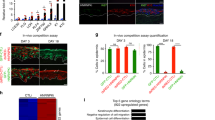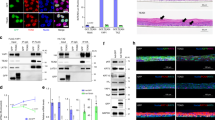Abstract
How the proto-oncogene c-Myc balances the processes of stem-cell self-renewal, proliferation and differentiation in adult tissues is largely unknown. We explored c-Myc’s transcriptional roles at the epidermal differentiation complex, a locus essential for skin maturation. Binding of c-Myc can simultaneously recruit (Klf4, Ovol-1) and displace (Cebpa, Mxi1 and Sin3a) specific sets of differentiation-specific transcriptional regulators to epidermal differentiation complex genes. We found that Sin3a causes deacetylation of c-Myc protein to directly repress c-Myc activity. In the absence of Sin3a, genomic recruitment of c-Myc to the epidermal differentiation complex is enhanced, and re-activation of c-Myc-target genes drives aberrant epidermal proliferation and differentiation. Simultaneous deletion of c-Myc and Sin3a reverts the skin phenotype to normal. Our results identify how the balance of two transcriptional key regulators can maintain tissue homeostasis through a negative feedback loop.
This is a preview of subscription content, access via your institution
Access options
Subscribe to this journal
Receive 12 print issues and online access
$209.00 per year
only $17.42 per issue
Buy this article
- Purchase on Springer Link
- Instant access to full article PDF
Prices may be subject to local taxes which are calculated during checkout







Similar content being viewed by others
References
Eilers, M. & Eisenman, R. N. Myc’s broad reach. Genes Dev. 22, 2755–2766 (2008).
Watt, F. M., Frye, M. & Benitah, S. A. MYC in mammalian epidermis: how can an oncogene stimulate differentiation? Nat. Rev. 8, 234–242 (2008).
Sodir, N. M. & Evan, G. I. Nursing some sense out of Myc. J. Biol. 8, 77.1–77.4 (2009).
Soucek, L. et al. Modelling Myc inhibition as a cancer therapy. Nature 455, 679–683 (2008).
Wilson, A., Laurenti, E. & Trumpp, A. Balancing dormant and self-renewing hematopoietic stem cells. Curr. Opin. Genet. Dev. 19, 461–468 (2009).
Habib, T. et al. Myc stimulates B lymphocyte differentiation and amplifies calcium signaling. J. Cell Biol. 179, 717–731 (2007).
Conacci-Sorrell, M., Ngouenet, C. & Eisenman, R. N. Myc-nick: a cytoplasmic cleavage product of Myc that promotes α-tubulin acetylation and cell differentiation. Cell 142, 480–493 (2010).
Stoelzle, T., Schwarb, P., Trumpp, A. & Hynes, N. E. c-Myc affects mRNA translation, cell proliferation and progenitor cell function in the mammary gland. BMC Biol. 7, 63–82 (2009).
Muncan, V. et al. Rapid loss of intestinal crypts upon conditional deletion of the Wnt/Tcf-4 target gene c-Myc. Mol. Cell. Biol. 26, 8418–8426 (2006).
Lawlor, E. R. et al. Reversible kinetic analysis of Myc targets in vivo provides novel insights into Myc-mediated tumorigenesis. Cancer Res. 66, 4591–4601 (2006).
Frye, M., Gardner, C., Li, E. R., Arnold, I. & Watt, F. M. Evidence that Myc activation depletes the epidermal stem cell compartment by modulating adhesive interactions with the local microenvironment. Development 130, 2793–2808 (2003).
Frye, M. & Watt, F. M. The RNA methyltransferase Misu (NSun2) mediatesMyc-induced proliferation and is upregulated in tumors. Curr. Biol. 16, 971–981 (2006).
Arnold, I. & Watt, F. M. c-Myc activation in transgenic mouse epidermis results in mobilization of stem cells and differentiation of their progeny. Curr. Biol. 11, 558–568 (2001).
Cole, M. D. & Cowling, V. H. Transcription-independent functions of MYC:regulation of translation and DNA replication. Nat. Rev. Mol. Cell Biol. 9, 810–815 (2008).
Cowling, V. H. & Cole, M. D. The Myc transactivation domain promotes global phosphorylation of the RNA polymerase II carboxy-terminal domain independently of direct DNA binding. Mol. Cell. Biol. 27, 2059–2073 (2007).
Rahl, P. B. et al. c-Myc regulates transcriptional pause release. Cell 141, 432–445 (2010).
Guccione, E. et al. Myc-binding-site recognition in the human genome is determined by chromatin context. Nat. Cell Biol. 8, 764–770 (2006).
Kim, J., Chu, J., Shen, X., Wang, J. & Orkin, S. H. An extendedtranscriptional network for pluripotency of embryonic stem cells. Cell 132, 1049–1061 (2008).
Fuchs, E. Finding one’s niche in the skin. Cell Stem Cell 4, 499–502 (2009).
Marenholz, I. et al. Genetic analysis of the epidermal differentiation complex (EDC) on human chromosome 1q21: chromosomal orientation, new markers, and a 6-Mb YAC contig. Genomics 37, 295–302 (1996).
Volz, A. et al. Physical mapping of a functional cluster of epidermal differentiation genes on chromosome 1q21. Genomics 18, 92–99 (1993).
Wang, X., Pasolli, H. A., Williams, T. & Fuchs, E. AP-2 factors act in concert with Notch to orchestrate terminal differentiation in skin epidermis. J. Cell Biol. 183, 37–48 (2008).
Lopez, R. G. et al. C/EBPα and β couple interfollicular keratinocyte proliferation arrest to commitment and terminal differentiation. Nat. Cell Biol. 11, 1181–1190 (2009).
Nair, M. et al. Ovol1 regulates the growth arrest of embryonic epidermalprogenitor cells and represses c-myc transcription. J. Cell Biol. 173, 253–264 (2006).
Wells, J. et al. Ovol2 suppresses cell cycling and terminal differentiation of keratinocytes by directly repressing c-Myc and Notch1. J. Biol. Chem. 284, 29125–29135 (2009).
Segre, J. A., Bauer, C. & Fuchs, E. Klf4 is a transcription factorrequired for establishing the barrier function of the skin. Nat. Genet. 22, 356–360 (1999).
Hurlin, P. J. et al. Mad3 and Mad4: novel Max-interacting transcriptional repressors that suppress c-myc dependent transformation and are expressed during neural and epidermal differentiation. EMBO J. 14, 5646–5659 (1995).
Hurlin, P. J. et al. Regulation of Myc and Mad during epidermal differentiation and HPV-associated tumorigenesis. Oncogene 11, 2487–2501 (1995).
Klose, R. J. et al. The retinoblastoma binding protein RBP2 is an H3K4 demethylase. Cell 128, 889–900 (2007).
Blackwood, E. M. & Eisenman, R. N. Max: a helix–loop–helix zipper protein that forms a sequence-specific DNA-binding complex with Myc. Science 251, 1211–1217 (1991).
Prendergast, G. C., Lawe, D. & Ziff, E. B. Association of Myn, the murine homolog of max, with c-Myc stimulates methylation-sensitive DNA binding and ras cotransformation. Cell 65, 395–407 (1991).
McMahon, S. B., Wood, M. A. & Cole, M. D. The essential cofactor TRRAPrecruits the histone acetyltransferase hGCN5 to c-Myc. Mol. Cell. Biol. 20, 556–562 (2000).
Ayer, D. E., Kretzner, L. & Eisenman, R. N. Mad: a heterodimeric partner for Max that antagonizes Myc transcriptional activity. Cell 72, 211–222 (1993).
Zervos, A. S., Gyuris, J. & Brent, R. Mxi1, a protein that specifically interacts with Max to bind Myc–Max recognition sites. Cell 72, 223–232 (1993).
Rao, G. et al. Mouse Sin3A interacts with and can functionally substitute for the amino-terminal repression of the Myc antagonist Mxi1. Oncogene 12, 1165–1172 (1996).
Laherty, C. D. et al. Histone deacetylases associated with the mSin3 corepressor mediate mad transcriptional repression. Cell 89, 349–356 (1997).
Hassig, C. A., Fleischer, T. C., Billin, A. N., Schreiber, S. L. & Ayer, D. E. Histone deacetylase activity is required for full transcriptional repression by mSin3A. Cell 89, 341–347 (1997).
Patel, J. H. et al. The c-MYC oncoprotein is a substrate of the acetyltransferases hGCN5/PCAF and TIP60. Mol. Cell. Biol. 24, 10826–10834 (2004).
Dannenberg, J. H. et al. mSin3A corepressor regulates diverse transcriptional networks governing normal and neoplastic growth and survival. Genes Dev. 19, 1581–1595 (2005).
Cowley, S. M. et al. The mSin3A chromatin-modifying complex is essential for embryogenesis and T-cell development. Mol. Cell. Biol. 25, 6990–7004 (2005).
Keller, A. et al. GeneTrailExpress: a web-based pipeline for the statistical evaluation of microarray experiments. BMC Bioinformatics 9, 552–558 (2008).
Zambelli, F., Pesole, G. & Pavesi, G. Pscan: finding over-represented transcription factor binding site motifs in sequences from co-regulated or co-expressed genes. Nucleic acid Res. 37, W247–W252 (2009).
McConnell, B. B. & Yang, V. W. Mammalian Kruppel-like factors in health and diseases. Physiol. Rev. 90, 1337–1381 (2010).
Payne, C. J. et al. Sin3a is required by sertoli cells to establish a niche for undifferentiated spermatogonia, germ cell tumors, and spermatid elongation. Stem Cells 28, 1424–1434 (2010).
van Oevelen, C. et al. The mammalian Sin3 proteins are required for muscle development and sarcomere specification. Mol. Cell. Biol. 30, 5686–5697 (2010).
van Oevelen, C. et al. A role for mammalian Sin3 in permanent gene silencing. Mol. Cell 32, 359–370 (2008).
Vervoorts, J. et al. Stimulation of c-MYC transcriptional activity and acetylation by recruitment of the cofactor CBP. EMBO Rep. 4, 484–490 (2003).
Popov, N., Schulein, C., Jaenicke, L. A. & Eilers, M. Ubiquitylation of the amino terminus of Myc by SCF(beta-TrCP) antagonizes SCF(Fbw7)-mediated turnover. Nat. Cell Biol. 12, 973–981 (2010).
Blanpain, C. & Fuchs, E. Epidermal homeostasis: a balancing act of stem cells in the skin. Nat. Rev. Mol. Cell Biol. 10, 207–217 (2009).
Soriano, P. Generalized lacZ expression with the ROSA26 Cre reporter strain. Nat. Genet. 21, 70–71 (1999).
David, G. et al. Specific requirement of the chromatin modifier mSin3B in cell cycle exit and cellular differentiation. Proc. Natl Acad. Sci. USA 105, 4168–4172 (2008).
de Alboran, I. M. et al. Analysis of C-MYC function in normal cells via conditional gene-targeted mutation. Immunity 14, 45–55 (2001).
Braun, K. M. et al. Manipulation of stem cell proliferation and lineage commitment: visualisation of label-retaining cells in wholemounts of mouse epidermis. Development 130, 5241–5255 (2003).
Hussain, S. et al. The nucleolar RNA methyltransferase Misu (NSun2) is required for mitotic spindle stability. J. Cell Biol. 186, 27–40 (2009).
Ren, B. et al. Genome-wide location and function of DNA binding proteins. Science 290, 2306–2309 (2000).
Gentleman, R. C. et al. Bioconductor: open software development for computational biology and bioinformatics. Genome Biol. 5, 80.1–80.16 (2004).
Smyth, G. in Bioinformatics and Computational Biology Solutions using R and Bioconductor (eds Carey, V., Gentleman, R., Dudoit, S., Huber, W. & Irizarry, R.) 397–420 (Springer, 2005).
Tai, Y. C. & Speed, T. P. On gene ranking using replicated microarray time course data. Biometrics 65, 40–51 (2009).
Toedling, J. et al. Ringo—an R/Bioconductor package for analyzing ChIP-chip readouts. BMC Bioinformatics 8, 221–225 (2007).
Littlewood, T. D., Hancock, D. C., Danielian, P. S., Parker, M. G. & Evan, G. I. A modified oestrogen receptor ligand-binding domain as an improvedswitch for the regulation of heterologous proteins. Nucleic Acid Res. 23, 1686–1690 (1995).
Acknowledgements
We thank the CRI Genomics and Bioinformatics Core Facilities. We are grateful to P. McDonel and everybody else who provided us with reagents. In particular, we thank A. Clarke for providing us with the Mycf/f mouse line and A. G. Smith for advice and comments on the manuscript. We further thank P. Humphreys, M. McLeish and N. Miller for their technical support. We acknowledge the support of the Cambridge Stem Cell Initiative, S. Evans-Freke, the ERC (DTO) and the EMBO Young Investigator Programme (DTO). This work was funded by Cancer Research UK (CR-UK) and the Medical Research Council (MRC).
Author information
Authors and Affiliations
Contributions
E.M.N. carried out experiments; C.L.C. carried out experiments; S.M. carried out bioinformatics analyses; S.H. carried out experiments; M.T. carried out bioinformatics analyses; S.B. carried out experiments; M.S. carried out bioinformatics analyses; J.N. provided reagents; B.K. carried out experiments; S.A.B. provided reagents; B.H. provided reagents; D.T.O. provided reagents and wrote the paper; M.F. designed the experiments and wrote the paper.
Corresponding author
Ethics declarations
Competing interests
The authors declare no competing financial interests.
Supplementary information
Supplementary Information
Supplementary Information (PDF 2397 kb)
Supplementary Tables 1–3
Supplementary Information (XLSX 366 kb)
Supplementary Table 4
Supplementary Information (XLSX 1249 kb)
Supplementary Table 5
Supplementary Information (XLS 92 kb)
Supplementary Table 6
Supplementary Information (XLSX 230 kb)
Supplementary Table 7
Supplementary Information (XLSX 85 kb)
Supplementary Table 8
Supplementary Information (PDF 104 kb)
Rights and permissions
About this article
Cite this article
Nascimento, E., Cox, C., MacArthur, S. et al. The opposing transcriptional functions of Sin3a and c-Myc are required to maintain tissue homeostasis. Nat Cell Biol 13, 1395–1405 (2011). https://doi.org/10.1038/ncb2385
Received:
Accepted:
Published:
Issue Date:
DOI: https://doi.org/10.1038/ncb2385
This article is cited by
-
MYC in liver cancer: mechanisms and targeted therapy opportunities
Oncogene (2023)
-
Transcriptome Analysis of Schwann Cells at Various Stages of Myelination Implicates Chromatin Regulator Sin3A in Control of Myelination Identity
Neuroscience Bulletin (2022)
-
RN7SK small nuclear RNA controls bidirectional transcription of highly expressed gene pairs in skin
Nature Communications (2021)
-
NAUTICA: classifying transcription factor interactions by positional and protein-protein interaction information
Biology Direct (2020)
-
DNA methylation-based chromatin compartments and ChIP-seq profiles reveal transcriptional drivers of prostate carcinogenesis
Genome Medicine (2017)



